 "orange ~ 13 muscle relaxants" courtesy of [Upupa4me via Flickr]
"orange ~ 13 muscle relaxants" courtesy of [Upupa4me via Flickr]
Health & Science
Suboxone Restrictions: Is it Possible to Fight Fire with Fire?
One of the tendencies people have when combating a problem is the tendency to over-correct. Rather than taking a moderate approach in the first place, they move from one extreme to another. Our drug and alcohol policy sometimes appears to be following that same tendency. Like the boom and bust of capitalism, we put cocaine in our soda and then switched to putting those who use the drug in jail. In the current climate, we have gone from drug companies and doctors promoting opioid painkillers as a life-saving innovation to defeat pain, to restricting the drugs we can use to combat addiction out of fear that it might contribute to the problem even more.
It is of course not an either/or proposition, yet we currently don’t place restrictions on opioid painkillers in the way that we restrict drugs used to treat those who are addicted to opioids. The fear is that if people have unlimited access to drugs like Suboxone they will abuse them rather than use them in recovery. Suboxone is a drug that can mimic some of the effects that opioids have on the brain in order to diminish cravings for and withdrawal from actual opioids. Addicts might also sell drugs like Suboxone to others. We’ve seen this happen with prescriptions for other drugs–in fact, it continues to be a major contributor to the opioid epidemic–so it is not surprising that this fear exists.
Some people will undoubtedly abuse access to Suboxone and drugs like it, the same way that some people abuse cough syrup, which is now restricted in many places. But do the potential abuses of Suboxone and other opioid addiction treatment drugs justify how we restrict them? Or are they such a necessary tool in combatting drug addiction that we should look for alternate means to prevent their abuse so more people can utilize them?
The Devil In the Details
To better understand restrictions on drugs like Suboxone we first need to understand exactly what these drugs do and how they can be dangerous.
When you take an opioid painkiller the drug activates the opioid receptors in the brain, which both blocks pain and creates the high associated with opioids. The more you take the less it becomes about reducing pain and the more it involves achieving that high. Eventually, the brain becomes accustomed to the opioid’s presence and you need more to get high, or even just to maintain normalcy and avoid withdrawal. Because of the way the body processes opioids, once you are chemically addicted to the drug you’ll never get rid of that reaction to it; your brain is permanently wired that way. Many people can and do quit using opioids and avoid addictive behaviors, but the inability to reset your brain chemistry to where it was originally is one of the things that makes opioid addiction particularly difficult to overcome.
Drugs that activate these opiate receptors in the brain are referred to as agonists. A full agonist opioid is a drug like heroin. An antagonist is a drug that attaches to the opiate receptors in the brain but does so without activating them, therefore blocking the opioid from attaching to those receptors. Antagonists, such as Naloxone, are typically used to reverse opioid overdoses and can have no opioid effect at all.
Why People are Uncomfortable With Suboxone
The trouble with Suboxone, in terms of getting skeptics’ approval to use it for addiction treatment, is that while it acts as an antagonist (it blocks opioids) it also acts as a partial agonist. Meaning that it works the same way an opioid does but to a lesser degree. So Suboxone will have some opioid effect–such as suppressing withdrawal symptoms and cravings for an addict–without providing a high.
It is the unique nature of drugs like Suboxone, which are both antagonists and partial agonists, that makes them so effective for the treatment of opioid addiction. They are able to deal with the symptoms of withdrawal and cravings that make addiction recovery so difficult as well as prevent addicts who relapse from getting the chemical rewards for their slip, which keeps that behavior from reinforcing the addiction. But it has led some to argue that giving Suboxone treatment to addicts is simply replacing one addiction with another. This same rationale is what limits maintenance treatment in drug courts, which you can read more about here. It’s an understanding of addiction that focuses on willpower and personal responsibility–which are important elements in combating addiction–but doesn’t give full credit to the best practices determined by the science of how certain drugs affect the body.
This video introduces some of the reasons–from the perspective of an addict and from medical professionals–why treatments with drugs like Suboxone are so effective.
Why Suboxone?
In fact, using partial agonists like Suboxone in treatment isn’t just one effective treatment option, it is the most effective treatment option. Opioid addicts who use the more common rehabilitation model of a 12-step Narcotics Anonymous style program without using opioid replacement medications are twice as likely to have a fatal overdose compared with addicts who use these medications. There have also been numerous studies that show that using these medications leads to other improvements in quality of life and reduces HIV transmission.
This is not to say that psychological treatments and communal supports such as Narcotics Anonymous are not a key component to addiction recovery. But they are often not enough to help most opioid addicts. Most opioid addicts would benefit from access to medications as well. This is like treating a cardiac condition by reducing stress through yoga and getting a pet. Both of those things are treatments that can help in your recovery but are part of a more complex treatment plan that includes other lifestyle changes and medication. A drug addiction recovery plan that dismisses medication as a potential tool is, according to many medical professionals, as unethical as a treatment plan for heart disease that ignores medication.
Regulations and Restrictions
Because of the fear that addicts will personally abuse or sell Suboxone and other partial agonists, federal regulations restrict the amounts that doctors can prescribe. In their first year practicing, doctors can treat 30 patients, and in subsequent years, they can treat 100 patients. This may seem like a lot, but in communities with thousands of addicts needing treatment and few doctors, these restrictions can prevent many people from getting these medications. Senators Ed Markey and Rand Paul introduced a bipartisan bill last year, known as The Recovery Enhancement for Addiction Treatment Act, which would allow nurse practitioners and assistants to administer these drugs, raise the first year cap from 30 patients to 100, and create a pathway for certain doctors to eliminate the patient cap altogether after their first year.
Recently the TREAT Act passed through the HELP Committee (Health, Education, Labor and Pensions). In the video below, Senator Rand Paul gives a brief explanation of why he is promoting this policy change:
Restrictions on Suboxone reduce its supply, and therefore, curtail its potential for abuse. But since there is no similar restriction on the amount of painkillers that doctors can prescribe–which is a huge contributing factor to the massive increase in opioid addiction and the sale of opioids–it makes little sense to restrict Suboxone. The use of Suboxone and other partial agonists won’t actually produce a high for an addict so there is less incentive for an addict to try to obtain Suboxone illegally when he or she could try to get full agonists and get high.
There are some drugs that can be used to replace opioids that produce similar euphoric effects, in a lesser quantity, but not all of them do. At best, the use of Suboxone will prevent withdrawal symptoms and block a full opioid from taking effect, which is exactly why they are helpful to addicts trying to quit their addiction. So while they could be misused and sold, their misuse isn’t damaging in the same way that misusing a prescription for Vicodin would be.
A better strategy for curtailing drug abuse would be to regulate the amount of full agonists that can be prescribed; if we are going to regulate anything. But this regulation would run into some of the same concerns that the current regulations for Suboxone do. Rather than encouraging or requiring proper training for those who are allowed to prescribe these drugs, regulations place a one-size-fits-all rule in every community. There may be some doctors in areas that have more patients in real need of opiates, just as there are communities where the demand for Suboxone has far outstripped doctors’ ability to provide treatment. Like the current regulation of Suboxone, regulations for painkillers would also reduce the supply of the drugs–but placing restrictions that are too harsh on painkillers reduces everyone’s ability to get them–even those who legitimately need them.
Conclusion
Regulations on drugs like Suboxone are an understandable reaction to a situation that has many lawmakers panicked. If the supply of drugs is causing a problem, then cracking down on the supply of drugs seems like the solution. The idea that the answer to bad drugs may be MORE drugs seems counterintuitive. And it is a tough sell in a culture that has been trained to treat addiction more like a psychological or spiritual dilemma than a medical one.
But drug addiction is a complex problem with psychological and medical components. Ignoring either of those elements makes combating addiction much more difficult and places more barriers in front of those in recovery. Changes in policy that allow patients to get individualized treatment for their illness, versus hoping you win the Suboxone lottery, will ultimately lead to better outcomes. Doctors do need appropriate training to deal with the specific issues involving opioid addiction. The medical profession has much to answer for when it comes to the promotion and prescription of unnecessary painkillers. But throwing the baby out with the bathwater and restricting their ability to prescribe effective treatment just because they had a hand in causing the disease is not effective.
Resources
The Washington Post: Getting Pain Killers Is Easy. Getting Help For Pain Killer Addiction Is Hard
The Huffington Post: Senate Bill Would Dramatically Alter Treatment For Heroin Addiction
Senator Edward Markey: TREAT Act One-Pager
The Daily Beast: Why Drug Rehab Is Outdated, Expensive and Deadly
Serenity Recovery: Kentucky Just Passed A New Law To Help Addicts
WJHL: New Tennessee Law Puts Restrictions on Suboxone, Subutex Prescribing
NAABT: What’s This Agonist/Antagonist Stuff?
PEWCharitableTrusts: States, CDC Seek Limits On Painkiller Prescribing








Comments